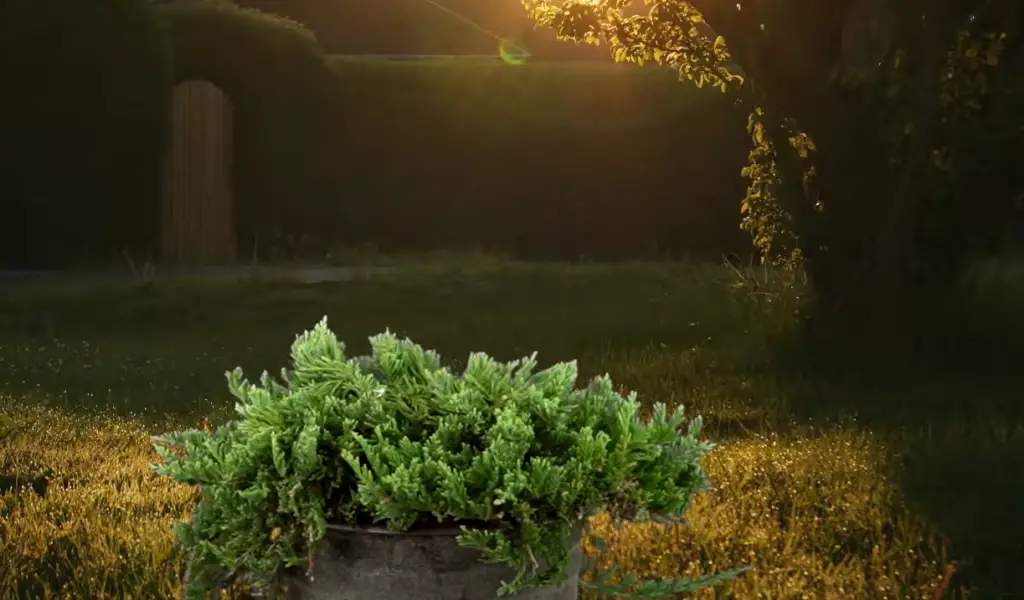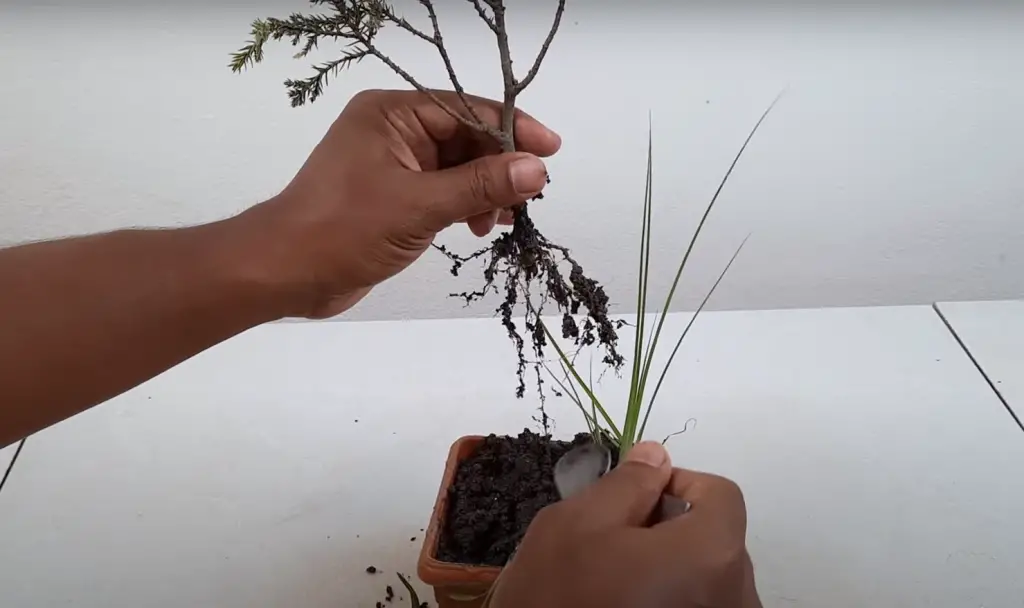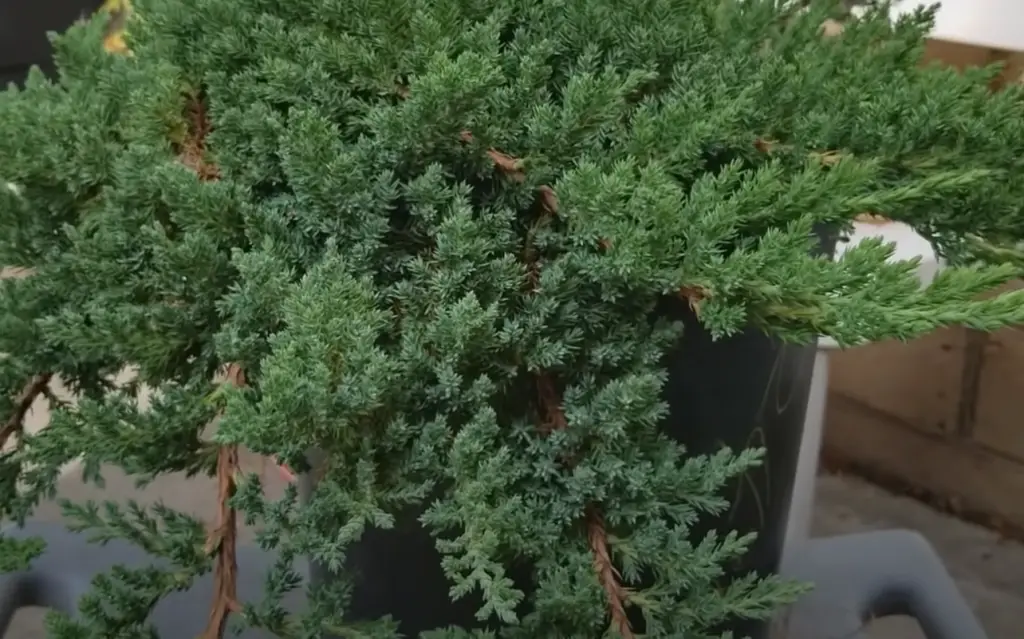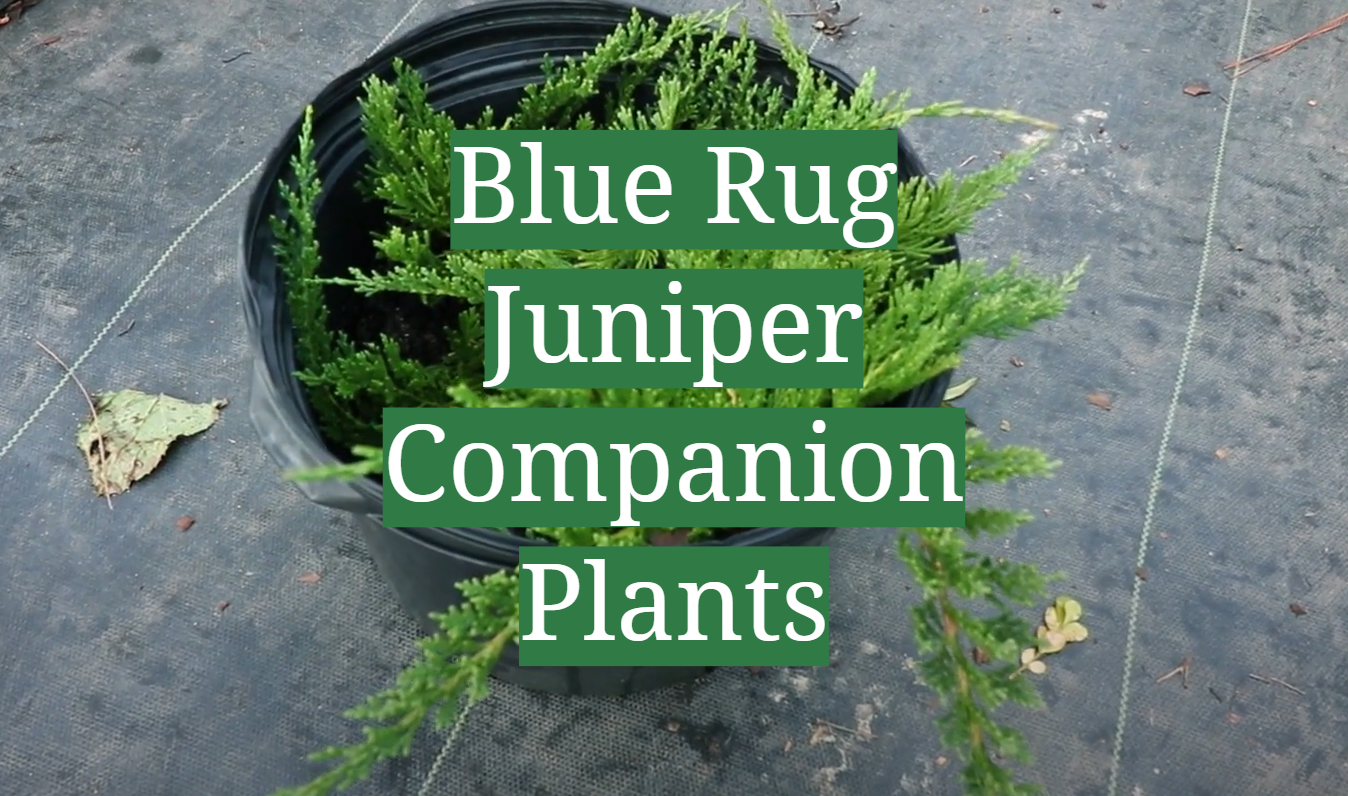For those looking to add a bit of color and texture to their garden, Blue Rug Juniper companion plants are an excellent choice. The bright blue foliage of the Juniper provides contrast and texture in any landscape design. These low-growing evergreen shrubs require minimal maintenance and can provide year-round interest in your garden. In this article, we will discuss the best Blue Rug Juniper companion plants, and answer some frequently asked questions about growing this attractive evergreen shrub.
Blue Poppies
Blue poppies are an ideal companion for Blue Rug Juniper. These perennials have stunning bright blue flowers that bloom in the spring and will add a splash of color to your garden. They thrive best when planted in well-draining soil, away from full sun exposure. Prune them regularly throughout the year to maintain their shape and size.[2]
Baptisia
Baptisia, also known as False Indigo, is an ideal companion plant for Blue Rug Juniper. This perennial shrub grows in upright clumps of bright green leaves and produces beautiful purple-blue flowers in the summertime.

Baptisia can reach heights up to two feet, and its deep roots make it drought tolerant and low maintenance. The foliage of this plant provides color and texture to the garden, and its flowers attract pollinators.
Lupine
Lupine is an excellent companion plant for Blue Rug Juniper because of its tall, vibrant flower spikes. Its showy pink and purple blooms will add a dramatic air to your landscape. Lupine makes a great container plant or can be planted directly in the ground. The foliage forms clumps which give this low-maintenance perennial its attractive form.[2]
Columbine
Columbine is a showy, low-maintenance perennial flower that can add color and texture to your garden. This hardy plant thrives in sunny locations with well-drained soil and easily tolerates partial shade. Columbine blooms from late spring to early summer, producing beautiful white, red, or yellow blossoms that attract hummingbirds and butterflies.
Blue Asters
One of the best companion plants to pair with Blue Rug Juniper are asters. The bright colors of the aster flowers will contrast nicely with the deep blue foliage of the juniper. Asters bloom in late summer and early fall, offering a colorful addition to your garden after other flowering annuals have faded away. They also attract bees and other pollinators, making them a great choice for those looking to create a habitat-friendly garden.
Dusty Miller
Dusty Miller (Senecio cineraria) is a great companion plant for Blue Rug Juniper. This silvery-gray foliage contrasts nicely with the bright blue of the Juniper, creating a beautiful look in any garden.
They will thrive in full sun to partial shade, and can tolerate a wide range of soil conditions.[2]Partridge Feathers for a Pop of Color
Partridge Feathers are a great companion plant to Blue Rug Juniper. This low-growing evergreen has soft, needle-like foliage that is covered in small white flowers during the summer months.

The delicate foliage provides an interesting texture and contrast in any garden design, while the white blooms add a splash of color to your landscape. Partridge Feathers are easy to care for, and are just as tolerant of drought and heat as the Juniper.[1]
Cushion Bush
Cushion Bush (Chamaecyparis pisifera) is an excellent companion plant for Blue Rug Juniper. The dense, mounding habit of Cushion Bush adds softness and texture to your landscape design. Its blue-green foliage provides an attractive contrast with the bright green needles of the Juniper. Cushion Bush requires little care and is drought tolerant once established. It’s a great choice for anyone looking to add a bit of color and texture to their garden without adding too much maintenance.
Seafoam Artemisia (Silver Mound)
Seafoam Artemisia (Silver Mound) is a great companion plant for Blue Rug Juniper. This low-growing herbaceous perennial is easy to care for and adds texture and silver-green color to the landscape. It can tolerate partial shade, making it an ideal choice for a shady border or container planting. Not only does it add color, but it also acts as a natural repellent against pests, making it an effective companion plant for the Blue Rug Juniper.
Veronica/ Speedwells
Veronica, or Speedwells, are a great companion for Blue Rug Junipers. These low-growing plants produce delicate blue, pink or white flowers in late spring and attract pollinators to your garden. Veronica’s mound of lacy foliage adds texture and color contrast to the bright blue foliage of the Juniper. It is important to note that Speedwells spread rapidly, so they should be planted in an area with plenty of space to allow the plant to grow.
Yucca
The Yucca plant is an excellent companion to the Blue Rug Juniper. It has similar sun and soil requirements, but adds texture to the landscape with its spiky leaves. The Yucca’s bold foliage will make a beautiful statement when planted in groups near your Blue Rug Juniper shrubs. Plus, many varieties of yucca blooms have striking white trumpet-shaped flowers that add a unique touch to your landscape.[2]
Agave Attenuata
One key to a successful companion plant pairing is selecting plants that have similar water and soil needs. Agave attenuata, commonly called the Foxtail Agave, is an excellent choice for a companion plant to Blue Rug Juniper. This succulent has unique foliage with striped patterns of green, yellow and white in long pointed leaves. It is a low-water plant that thrives in full sun, making it a great match for the Juniper.
Sedum
One of the most popular companion plants for Blue Rug Juniper is Sedum. Sedums come in a wide range of colors and textures, so you can easily find one to suit your garden and landscape design needs. They also require minimal maintenance, making them an ideal choice when it comes to companion planting. The low-growing foliage of Sedum will help to add texture and contrast to the bright blue foliage of the Juniper.[3]
Euphorbia
Euphorbia is an excellent companion plant for Blue Rug Juniper, as its silvery foliage and bright yellow flowers provide a striking contrast to the blue foliage. This low-growing evergreen groundcover can spread quickly if not kept in check. It thrives in well-drained soils and full sun, but will tolerate some shade.[3]
Lavender
Lavender is a classic companion plant for the Blue Rug Juniper, and can provide stunning contrast in any garden. Not only does it look great with its bright purple flowers, but also its fragrant aroma will add a delightful scent to your landscape.

Lavender should be planted in well-drained soil that receives plenty of sun and airflow. Prune the lavender to maintain a neat shape and encourage more growth.[3]
Dwarf Alberta Spruce
Dwarf Alberta Spruce is an excellent companion plant for Blue Rug Juniper. With its short, dense foliage and conical shape, it provides a nice contrast to the spreading habit of the Juniper. This evergreen shrub also has lovely silvery-blue needles that provide year-round interest in your garden. Dwarf Alberta Spruce prefers well-drained soil and full sun or partial shade.
Kramers Red Winter Heath
Kramers Red Winter Heath is a great companion plant for Blue Rug Juniper. This low-growing evergreen shrub has stunning dark green leaves, which offer a beautiful contrast to the bright blue foliage of the Juniper. The red flowers that appear in winter provide an extra burst of color and add interest to any garden design.
Barberry
Barberry is a great choice for Blue Rug Juniper companion plants as it provides an interesting contrast with its spiny leaves and colorful berries. Barberry also offers interest in the winter when other plants have lost their foliage, and can help provide year-round color to your landscape design. Additionally, Barberry grows well in full sun areas and requires very little maintenance.
Roses
Roses are a popular choice to pair with Blue Rug Juniper. As a low-growing evergreen shrub, the Juniper provides an excellent backdrop for roses of all colors and sizes. Roses can also be used as a groundcover in areas where the Juniper will not thrive or is too large for the space.
Other Plant Categories
Vines and GroundCovers
Vines and groundcovers are a great way to add texture and color to your landscape design. Morning Glory, Honeysuckle, Variegated Sweet Flag, Creeping Phlox and English Ivy are all good choices for companion plants for the Blue Rug Juniper. Vines will add height and interest to an area where the Juniper is too small, while groundcovers will help to keep weeds away and add texture.[4]
Bulbs
Bulbs are an excellent choice for companion planting with Blue Rug Juniper, as they provide a burst of color in the spring and summer months. Tulips, Daffodils, Alliums and Anemone are all good choices for bulbs that will pair well with this evergreen shrub. Bulbs should be planted in early fall to ensure they bloom in time and can be replaced each year for a new look.
Hanging Plants
Hanging plants are a great way to add vertical interest to your garden and can be used as an alternative to tall shrubs in areas with limited space. Trailing Petunia, Million Bells, Ivy Geraniums and Licorice Plant are all good choices for companion plants for Blue Rug Juniper. Hanging baskets provide vibrant color against the backdrop of the Juniper’s bright blue foliage.
The Shade Lovers
The Blue Rug Juniper does best in full sun, but there are some companion plants that prefer shade. Hosta, Hydrangea and Ferns all thrive in shady conditions and make a great contrast to the bright blue foliage of the Juniper. These plants can be used as groundcovers or planted among other shrubs for a beautiful landscape design.[4]
Specimen Plants
If you have a large area that can accommodate larger plants, consider planting some show-stopping specimen plants to pair with your Blue Rug Juniper. Japanese Maples, Dogwood trees and Magnolia trees all provide interesting textures and colors to contrast the bright blue foliage of the Juniper. These larger plants will also help to create a sense of scale in your garden design.

Planting companion plants alongside Blue Rug Juniper can add texture, color and interest to your landscape. Consider the different types of plants that thrive in full sun and create a vibrant display with their unique foliage and blooms. With careful selection of companion plants, you can have an attractive garden that will provide interest year-round.
FAQ
What plants look good with Blue Star juniper?
Many plants can be used as companion plants for Blue Star juniper, including Sedum, Euphorbia, Lavender, Dwarf Alberta Spruce, Kramers Red Winter Heath and Barberry. These plants provide contrasting foliage and colors that make a stunning display when planted alongside the blue-green juniper. Other plant categories to consider include vines and groundcovers, bulbs, hanging plants, shade lovers and specimen plants.
What goes well with juniper?
Many plants go well with juniper, including Sedum, Euphorbia, Lavender, Dwarf Alberta Spruce, Kramers Red Winter Heath and Barberry. These can be planted alongside the juniper to create a stunning display of contrasting foliage and colors. Other types of companion plants that work well with juniper include vines and groundcovers, bulbs, hanging plants, shade lovers and specimen plants.
Does Blue Rug Juniper spread?
Yes, Blue Rug Juniper does spread and can become a bit unruly if not pruned regularly. The spreading habit of this evergreen shrub makes it great for groundcover in larger areas. The foliage is bright blue-green in color and the branches grow horizontally, which helps to create an attractive contrast with other plants in your garden design. Prune regularly to encourage more dense foliage and help keep the plant from becoming too large.
Can you plant junipers close to house?
Yes, junipers can be planted close to the house as long as they have enough space for their roots. Juniper’s low profile and evergreen foliage make it a great choice for foundation planting in front of a home.
Additionally, juniper’s shallow roots may present a problem for foundations in dry climates, so be sure to check with your local extension office for guidance on the best placement of these plants.Can you plant blue point juniper next to house?
Yes, blue point juniper can be planted next to the house as long as there is enough space for its roots. Juniper’s low profile and evergreen foliage make it a great choice for foundation planting in front of a home.

Additionally, since the blue point juniper has an upright habit, it makes a great back-drop for other plants in the garden. Just be sure to leave enough space around the plant to allow it to grow and spread without crowding other plants or structures.
Do junipers have deep roots?
No, junipers typically have shallow root systems that spread horizontally rather than deeply into the ground. This makes them ideal for landscapes with rocky or sandy soils, as their roots can find nutrients near the surface without becoming too invasive. However, they may need supplemental watering during periods of drought to ensure they stay healthy and green.
Where do junipers grow best?
Junipers grow best in full sun and well-drained soil. They can tolerate a variety of soils, from sandy to clay, but prefer neutral to slightly acidic pH levels. Junipers are fairly drought tolerant once established, so they don’t require a lot of supplemental watering or fertilization. However, they will benefit from regular pruning and trimming to promote thick, dense growth.
Can juniper get too much sun?
Yes, juniper can get too much sun and may suffer from sunburn or dehydration if left without any shade for extended periods of time. When planting junipers in full sun, be sure to provide some afternoon shade or use a mulch layer around the plants to protect their roots from heat stress. Additionally, water your junipers frequently during hot weather to ensure they stay hydrated and healthy.
Useful Video: How to grow Blue Rug Juniper with detailed description
Conclusion
Blue Rug Juniper is an attractive, low-maintenance evergreen shrub that makes a great addition to any landscape. It’s bright blue foliage provides year-round color and texture when paired with the right companion plants. Consider shade lovers like Hosta, Hydrangea and Ferns or larger specimens such as Japanese Maples and Dogwood trees to create a stunning display. Be sure to provide adequate water and fertilization for your junipers, as well as regular pruning to keep them looking their best. With the right selection of companion plants, you can have an eye-catching landscape that will be enjoyed for years to come.
Happy gardening!
References:
- https://www.gfloutdoors.com/blue-rug-juniper-companion-plants-what-to-plant-next-to-junipers/#
- https://www.fallsgarden.com/juniper-companion-plants/
- https://bigboyplants.com/blue-rug-juniper-juniperus-horizontalis-wiltonii-care/
- https://www.familyfoodgarden.com/blue-star-juniper-companion-plants/










Leave a Reply
View Comments